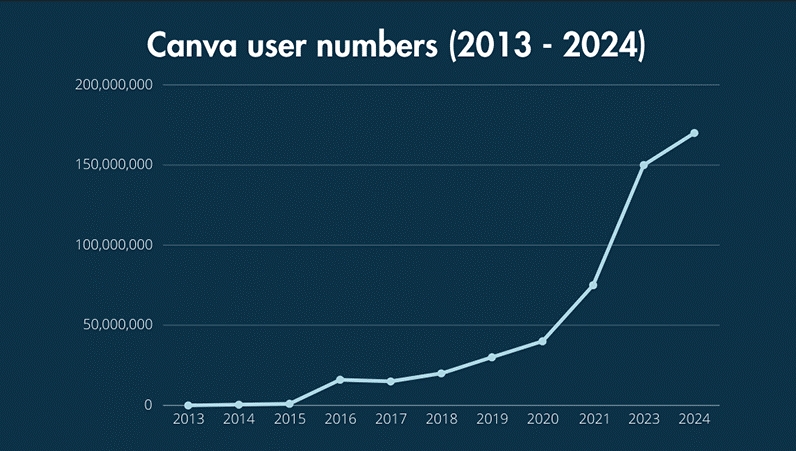In the competitive world of design tools, Canva stands out as a beacon of innovation and success. From its humble beginnings to its current status as a leading design platform, Canva’s journey offers valuable insights for startups. In this article, we’ll explore how Canva disrupted the design industry and what lessons can be drawn for new businesses looking to make their mark.
The Birth of Canva: A Vision for Simplicity
Melanie Perkins, inspired by her experiences teaching design software, envisioned a platform that made design accessible to everyone. Her frustration with complex tools led to the creation of Fusion Books, a design platform for school yearbooks. This early venture provided a foundation for Canva’s development, demonstrating how identifying and solving user pain points can be a powerful catalyst for innovation. Perkins’s journey and the foundational principles of Canva are explored in detail on TechCrunch, highlighting the impact of simplicity in tech startups.
User-Friendly Design: The Key to Canva’s Success
One of Canva’s standout features is its user-friendly interface. Unlike traditional design software that often requires extensive training, Canva’s drag-and-drop functionality allows users of all skill levels to create professional designs quickly. This simplicity has been crucial in attracting a broad audience, proving that ease of use can significantly enhance user adoption. For a deep dive into how user-friendly design contributes to tech success, see Forbes.

The Freemium Model: Attracting and Retaining Users
Canva’s freemium model has been instrumental in its rapid growth. By offering basic design tools for free, Canva attracts a large user base, many of whom later choose to upgrade for additional features. This approach not only lowers the barrier to entry but also encourages users to explore the platform’s full capabilities, illustrating how a well-structured pricing model can drive user engagement and growth. Insights on the effectiveness of freemium models are discussed in Entrepreneur.
Early Struggles and Milestones: Navigating Growth Challenges
Canva’s journey wasn’t without its challenges. Securing initial funding and gaining traction were significant hurdles. However, perseverance and strategic investments helped overcome these obstacles. Startups can learn from Canva’s experience that navigating early growth challenges requires resilience and strategic planning.
Innovations That Changed the Game: Expanding Features
Canva continuously evolves by introducing new features and tools. The launch of Canva’s Video Suite and game templates expanded its functionality, making it a versatile tool for various needs. This commitment to innovation demonstrates the importance of continuously improving and adapting to meet changing user needs.

The Power of Organic Growth and Social Media
Canva’s organic growth strategy, driven by strong social media presence and word-of-mouth referrals, has been crucial to its success. By focusing on building a community and engaging users through social platforms, Canva has achieved impressive growth without relying heavily on paid marketing. This approach highlights the value of leveraging organic channels to build brand awareness and drive user acquisition.
Lessons for Startups: Addressing Market Gaps
Startups can draw several lessons from Canva’s success:
- Identify Market Gaps: Just as Canva addressed the complexity of traditional design tools, startups should seek out and address existing gaps in the market. Understanding user pain points and creating solutions that address these issues can differentiate a new business from established competitors.
- Prioritize User Experience: Canva’s intuitive design is a testament to the importance of user experience. Startups should focus on creating products that are easy to use and provide a seamless experience, as this can significantly impact user satisfaction and retention.
- Leverage Freemium Models: Offering a freemium model can attract a large user base and allow potential customers to experience the value of a product before committing to a paid version. This strategy can help build a strong foundation of users who are likely to convert to paying customers over time.
- Embrace Continuous Innovation: To stay ahead of competitors, startups should prioritize continuous improvement and innovation. Regular updates and new features can keep users engaged and ensure that a product remains relevant in a fast-paced market.
- Utilize Organic Growth Strategies: Building a strong presence on social media and leveraging word-of-mouth referrals can be effective strategies for driving growth. Startups should focus on creating valuable content and engaging with their audience to build a community around their brand.

Conclusion
Canva’s story is a powerful example of how innovation and a user-centric approach can disrupt an industry. By simplifying design tools, adopting a freemium model, and continuously evolving, Canva has set a high standard for startups. As new businesses look to compete with industry giants, they can draw valuable lessons from Canva’s success and apply these strategies to carve out their own space in the market.
Join the Founders Lab
Ready to take your startup to the next level? Join the Founders Lab at pplelabs. The Founders Lab is an accelerator program that gives its founders the resources needed to build and scale their products, whether it’s apps, websites, or cloud solutions. The program offers access to:
- Developers: Frontend, Backend, DevOps, and QA engineers.
- Designers: UX, UI, Graphic, Content, and Product designers.
- Product Managers: Technical PMs and Scrum Masters.
- Marketers: Customer Success experts and Growth Hackers.
Don’t miss this opportunity to elevate your startup with expert support and resources. Limited spaces, you can apply here.
FAQs
What was Canva’s initial goal? Canva aimed to simplify the design process and make it accessible to everyone, overcoming the complexity of traditional design tools.
How did Canva grow so quickly? Canva’s rapid growth was driven by its user-friendly interface, freemium model, and effective organic growth strategies, including strong social media engagement.
What features make Canva unique? Canva’s intuitive drag-and-drop design, extensive template library, and collaborative tools make it stand out. Its freemium model also attracts a broad user base.
How does Canva’s freemium model benefit users? The freemium model allows users to access basic features for free, lowering the barrier to entry and enabling users to explore the platform before committing to a paid version.
What lessons can startups learn from Canva? Startups can learn the importance of identifying market gaps, prioritizing user experience, leveraging freemium models, embracing continuous innovation, and utilizing organic growth strategies to achieve success.


Leave a Reply